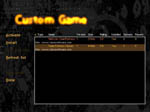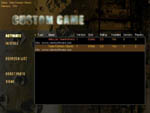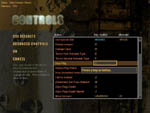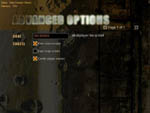Today, Robin Walker sent us news of the Mod interface they have been working on at Valve. The following is his announcement along with thumbnails and links to full sized screen shots.
Hi!
Over the past few weeks we've been working a lot on our Mod
interface in
Half-Life, using Team Fortress Classic as a method of testing it. As
a Mod
maker myself, it's been great to see Valve treating mod makers with
such
respect, and I've been bursting to tell the world about our new
interface.
Luckily, Gabe finally let me do so before I exploded.
So, this email's a description of what we tried to set out to do
with the Mod
interface, what it does, and how it'll benefit both Mod makers and
mod players
alike. I've attached some screenshots to better explain some of it.
I started as
a Mod maker, and if I'd had anything like this, it would have been a
thousand
times easier to get my Mods into the player's hands.
Right now, pretty much regardless of FPS, if I write a Mod, I need
to rely upon
my players for a variety of things. They have to find out about my
Mod, which
is an enormous first step. Then, they have to download it (not too
hard), install
it (not too hard either, if I put in some effort and make an
installation package),
and then run the FPS using my Mod's code instead of the original
code. This
requires the use of command line parameters. Judging from the number
of
emails I've got on this subject since starting Team Fortress,
there's an enormous
number of players out there on FPS servers who don't know what the
command
line is, let alone how to use it to specify a custom game.
Now they've finally got my Mod running, they need to know how to
play, and
most importantly, any new commands my Mod has. As a Mod maker, I can
put
my command list in the readme.txt, but its been proven many times
that no-one
reads that anyway. Should my enterprising player actually find the
command list
in the readme.txt or on my web page, he/she then needs to know how
to use them.
You do know how to use the console and bind keys, right?
I remember awhile ago when Gabe found out what a player needed to
know to play
Team Fortress. He was amazed anyone played it at all.
So, with Half-Life's Mod interface, we set out to remove all these
obstacles, and
provide a nice pipeline between Mods and Players. We wanted Mod
makers to only
have to worry about their part of the bargain (making the mod!). We
wanted players
looking for Mods to easily find them, easily install them, and
easily play them. We
wanted players who didn't even know Half-Life had a console to be
able to play Mods!
To make it easy for players to find Mods, we invented the Mod
Browser. We created
a Mod Master Server that keeps track of every Half-Life Mod in the
world, what version it's
up to,where it can be downloaded, and so on. Using the Half-Life
launcher, you can simply
browse the list of Mods, pick the one you want, and hit the Install
button. The Mod is
downloaded and installed automatically. If there's a new version of
a Mod you've already
got, the Mod Browser automatically warns you, and asks you if you
want to download it.
Each Mod has a link to it's web page so players can more easily find
the type of Mod
they're looking for.
Here's a screenshot of the Mod Browser:

Running a Mod is just as easy. In the Mod Browser, you just pick the
Mod you want to
play, and hit the Activate button. The Launcher now enters Custom
Game mode, where
every piece of art and data can be replaced by the Mod.
Here's a screenshot of the Mod Browser after Team Fortress Classic
has been activated:

We've made it easy for a Mod maker to distribute his/her Mod. A Mod
maker now only
needs to make a Mod, tell the Mod Master Server that it exists, and
bang, everyone in
the world knows about your Mod. Players simply hit the Install
button, the Mod is downloaded,
and all files are placed in the right directories. You're ready to
go!
Next problem: How do we make it easy for players to play Mods? We
knew from the feedback
we'd got from Half-Life that players found the Launcher easy to use,
allowing them to play
multiplayer without having to use other programs to find servers or
setup keys. The most
obvious thing to do was to let Mod makers use the same interface.
So we enhanced the Launcher's Custom Game interface, allowing a Mod
to completely customize
not just its graphics, but it's content. If you go to the
Customize->Controls section of the Launcher
while a Mod is active, you can customize all the new commands and
settings the Mod needs,
including default key settings for new players.
Here's a screenshot of the Customize Controls screen while running
Team Fortress Classic:

Finally, Mods can also customize the player setup sections, adding
new player settings specifically
needed for this Mod. Team Fortress Classic uses these to allow
players to automatically have config
files executed when they change classes, among other things.
Here's a screenshot of the Advanced Customization for Team Fortress
Classic:

We're very happy with how the Mod interface has turned out. Team
Fortress Classic has been
the ideal test case for it. Wherever possible, problems that cropped
up for Team Fortress Classic
were solved in generic ways that will benefit Mod makers everywhere.
As a Mod maker, I'm very excited to see the Mods that'll come out of
this. Making it extremely
easy for Mod makers to get their Mods to the players, and for
players to get in and play them
can only be a good thing for the Mod community.
Robin Walker.
. . . . . . . . . . . . . . . . . . . . . . . . . . . . . . . . . . . . . . . . . . . . . . . . . . . . . . . . . . . . . . . . . . . . . . . . . . . . . . . . . . . . . . . . . . . . . . . . . . . . . . . . . . . . . . . . . . . . . . . . . . . . . . . . . . . . . . . . . . . . . . . . . . . . . . . . . . . . . . . . . . . . . . . . . . . . . . . . . . . . . . . . . . . . . . . .
|